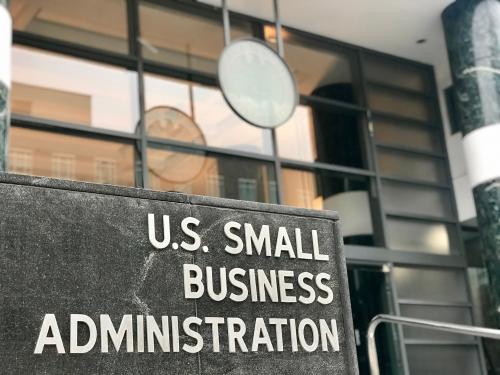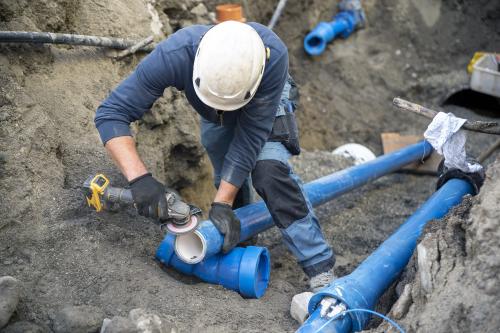Federal policymakers are on the verge of advancing two historic pieces of legislation: a $1.2 trillion bipartisan infrastructure bill and a $3.5 trillion reconciliation package. The infrastructure bill contains generational investments in transportation, water, energy, and other systems to improve the environment and boost the economy—at spending levels not seen since the New Deal. The reconciliation package goes a step further, aiming to address a variety of climate, education, health care, and other priorities.
While the ultimate fate of both is up in the air, one point is clear: Policymakers are focused on creating more jobs and supporting more workers following the COVID-19 recession. And the potential for infrastructure investment to deliver a needed jolt to the labor market continues to attract bipartisan interest, which makes sense given the competitive wages, lower formal educational barriers to entry, and looming hiring needs in this sector.
But simply spending more money on infrastructure is no guarantee that all people in all places will benefit, including the unemployed, underemployed, and out of work. Many prospective infrastructure workers may lack the training, experience, or supportive services to quickly fill open positions in the skilled trades and related fields.
In other words, the politics of the federal infrastructure debate will quickly transition to implementation challenges at the federal, state, and local level—challenges around engaging, hiring, and training the next generation of infrastructure workers. Now is the time to start developing and testing new approaches to strengthen a long-term talent pipeline, and not just scramble to fill short-term jobs.
That requires proactive outreach to students and younger workers who have shied away from career and technical education in recent years; retraining middle-aged and other nontraditional job seekers; supporting work-based learning opportunities, including apprenticeships and pre-apprenticeships, that are essential to qualify for infrastructure jobs; and taking other steps to strengthen infrastructure career pathways. Educational institutions, workforce development boards, labor groups, community organizations, and infrastructure employers—from transportation departments to water utilities to engineering firms—are among the regional leaders that play a central role coordinating all this activity. The problem is that many of them operate in siloes, still rely on outdated and rigid hiring strategies, and struggle to address a widening talent gap amid a rapid rise in retirements.
Whatever happens in Washington, regional leaders need to be ready to hit the ground running in advance of any additional federal funding. Below are five ways regional leaders can use the current federal moment to drive more enduring economic opportunity.
1. Rethink what an ‘infrastructure job’ means
If additional federal funding comes through, many regional leaders will be inclined to throw more money toward a backlog of existing projects and rely on existing workers. If the last recession offers any indication, leaders tend to focus on “shovel-ready” projects and jobs, and economists are already projecting the creation of anywhere from 650,000 to 1 million jobs from the infrastructure bill alone, primarily in construction and manufacturing. However, the COVID-19 recession is different; construction unemployment is far lower (4.6% last month compared to 20% in 2010), meaning there are fewer of these workers sitting on the sidelines. Instead, many unemployed workers today are concentrated in retail, hospitality, and other service industries.
Put another way, filling infrastructure jobs goes far beyond construction—leaders must focus on the multiple branching career pathways involved in infrastructure operation and maintenance. Construction laborers, highway maintenance workers, and other production occupations offer hundreds of thousands of employment opportunities, but they can obscure the full range of the 17.2 million jobs involved in managing ports, delivering electricity, fixing broadband, and more. Many of these workers are also involved in finance, administration, and human resources; think of all the workers overseeing budgets, designing projects, and fielding calls at a utility or transportation department, for instance.
Not everyone can or wants to wear a hard hat. Many unemployed and underemployed workers have customer service skills or other experience that could translate well into a variety of infrastructure jobs. Creating a stronger, lasting foundation for economic opportunity demands clearer recognition of all types of infrastructure career pathways across a project’s full lifecycle.
2. Emphasize high-growth jobs and jobs with enormous replacement needs
Infrastructure hiring needs are not just about new positions emerging in years to come, but also about filling existing positions that have lost (or will lose) workers. New jobs in clean energy and green infrastructure are among the fastest-growing nationally and vital for addressing a changing climate. However, across the entire infrastructure sector, nearly 1.5 million workers—or 10.4%—are projected to permanently leave their jobs on average each year over the next decade. An aging workforce and mounting retirements partially explain this high separations rate, as does an inability to hold onto workers who may simply quit and leave these jobs for opportunities in other industries.
Either way, there are a lot of shoes to fill. Regional leaders should not simply concentrate on wind turbine service technicians and solar photovoltaic installers—they need to find enough electricians, plumbers, and truck drivers too.
3. Strengthen regional coordination around planning and training
Infrastructure jobs share many of the same skills and training needs, yet employers routinely struggle to build or pull from a larger, common pool of labor. Half (53.4%) of infrastructure workers have a high school diploma or less; they typically develop more skills on the job, including familiarity with tools and knowledge in STEM fields. However, rather than collaborating to create common curricula and more flexible pathways, many educational institutions and workforce development organizations focus on a narrow range of credentials while employers compete against each other and hoard scarce talent.
Regional leaders need to bridge planning and communication gaps across different infrastructure siloes and employers, including water utilities, transportation departments, energy providers, telecommunications companies, and others. The emergence of “infrastructure academies” and other sector strategies—including regional partnerships and programs to identify hiring needs, share training resources, and evaluate outcomes—hold promise in coordinating and accelerating action.
4. Focus on equity and inclusion
Infrastructure jobs offer more competitive and equitable wages, including up to 30% higher pay for lower-income workers and those just starting their careers. But ensuring prospective workers can actually reach the beginning rungs of the infrastructure career ladder remains a challenge, especially for women and people of color who are continually underrepresented across these jobs. The lack of gender and racial diversity results from several factors: a lack of visibility and community engagement around infrastructure careers; a lack of supportive services, including child care and transportation access; and a lack of employer flexibility and resources to help nontraditional individuals navigate training and workplaces that may not always be welcoming.
Federal agencies, including the Department of Labor, the Department of Transportation, the Environmental Protection Agency, and the Department of Energy, have increasingly emphasized equity and inclusion in their plans and programs—even more so following an executive order from the Biden administration. Whether they are already doing it or not, regional leaders should similarly look to view their infrastructure workforce needs in light of the needs of their entire community—in line with strategies emerging nationally around a more equitable post-COVID economy.
5. Experiment with new projects and procurement strategies
As it stands, the infrastructure bill does not contain much direct workforce development funding; it mostly focuses on getting more funding to infrastructure projects. Meanwhile, the reconciliation package proposes to do more on education and workforce programming, but many details are still missing. The ultimate labor market impacts—and the realities individual workers will face—will hinge on the types of infrastructure projects pursued, from their duration to their location to their execution. And traditionally, regional leaders have pursued many of the same designs, materials, and approaches that have left a legacy of harm for generations.
However, experimenting with new types of projects and rethinking the objectives of these projects—including economic opportunity, workforce development, and so on—have the potential to involve more and different types of people and lead to better regional outcomes. For instance, there has been a recent push among several regional leaders to allow more local hiring for infrastructure projects that receive federal funding. Similar steps to connect to local minority- and women-owned business enterprises as part of the procurement process have also taken root in some regions.
Even amid uncertainty, regional leaders should plan for a workforce opportunity
There is still widespread uncertainty of what will happen to the infrastructure bill and reconciliation package. But regional leaders should not sit idle if they want to maximize the reach of any new federal infrastructure funding. That’s especially true when it comes to seizing an infrastructure workforce opportunity that may not come for another generation.
Whether repairing roads, fixing pipes, or installing cables, millions of workers will need to carry out these tasks. The major questions are: who will they be, where will they come from, and how will they get ready? Regional leaders—not just federal leaders—will play a key role determining the answers.
The Brookings Institution is committed to quality, independence, and impact.
We are supported by a diverse array of funders. In line with our values and policies, each Brookings publication represents the sole views of its author(s).




Commentary
Five ways regional leaders can prepare future infrastructure workers now
September 16, 2021